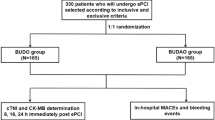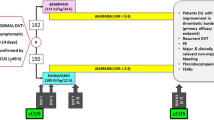Abstract
Background: Many cardiologists continue to be reluctant to utilize low-molecular-weight heparin in the treatment of patients with non-ST-segment-elevation acute coronary syndrome because they are concerned about how to manage such patients if they have received only one dose of subcutaneous enoxaparin and are then taken within hours of such treatment to the cardiac catheterization laboratory for percutaneous coronary intervention (PCI). Although we and others have recommended that such patients who have received only one subcutaneous enoxaparin dose receive an intravenous 0.3 mg/kg enoxaparin “booster” dose immediately prior to PCI, there are little actual data to support this recommendation.
Methods: 20 middle-aged subjects were treated with 1 mg/kg subcutaneously-administered enoxaparin and then 6 hours later with a “booster” dose of 0.3 mg/kg intravenously-administered enoxaparin. Anti-Xa levels, as well as ENOX Times, were assessed at baseline, at 2, 4 and 6 hours after the initial SC dose, and at 5 min, 1 and 2 hours after the IV booster dose.
Results: At 2 and 6 hours after the initial subcutaneous enoxaparin dose, thirty-five percent of patients had anti-Xa levels below 0.6 IU/mL; twenty percent and ten percent had anti-Xa levels below 0.5 IU/mL at 2 and 6 hours after the initial subcutaneous dose, respectively. After the IV booster dose, all patients had anti-Xa levels in the therapeutic range during the 5 minutes to 2 hours during which blood samples were obtained. There was no significant “overshoot” with this booster dose above what is considered to be the upper therapeutic range. ENOX times showed an overall moderate correlation with anti-Xa levels.
Conclusions: A strategy of administering a 0.3 mg/kg IV booster dose to patients who have received only one subcutaneous dose of enoxaparin and then undergo PCI within the first 2–6 hours of such treatment reliably leads to anti-Xa levels in the therapeutic range.
Similar content being viewed by others
References
Collet JP, Montalescot G, Lison L, et al. Percutaneous coro-nary intervention after subcutaneous enoxaparin pretreat-ment in patients with unstable angina pectoris.Circulation 2001;103:658–663.
Martin JL, Fry ETA, Serano A, et al. Pharmacokinetic study of enoxaparin in patients undergoing coronary in-tervention after treatment with subcutaneous enoxaparin in acute coronary syndromes. The PEPCI study. Eur Heart J 2001;22(Suppl):14.
Ferguson JJ, Antman EM, Bates ER, et al. Combining enoxaparin and glycoprotein IIb/IIIa antagonists for the treatment of acute coronary syndromes: Final results of the National Investigators Collaborating on Enoxaparin-3 (NICE-3) study. Am Heart J 2003;146:628–634.
Fox KAA, Antman EM, Cohen M, et al. Comparison of enoxaparin versus unfractionated heparin in patients with unstable angina pectoris/non-ST-segment elevation acute myocardial infarction having subsequent percutaneous coronary intervention. Am J Cardiol 2002;90:477–482.
Levine GN, Ferguson JJ. Low-molecular-weight heparin during percutaneous coronary interventions: Rationale, results, and recommendations. Catheter Cardiovasc Interv 2003;60:185–193.
Kereiakes DJ, Tcheng J, Fry ET, et al. Pharmacoinvasive management of acute coronary syndrome in the setting of percutaneous coronary intervention: Evidence-based, site-and spectrum-of-care strategies for optimizing patient out-comes in NSTE-ACS. J Invasive Cardiol 2003;15:536–553.
Moliterno DJ, Hermiller JB, Kereiakes DJ, et al. A novel point-of-care enoxaparin monitor for use during percu-taneous coronary intervention: Results of the evaluating enoxaparin clotting times (ELECT) study. J AmColl Car-diol 2003;42:1132–1139.
Hirsh J, Warkentin TE, Shaughnessy SG, et al. Heparin and low-molecular-weight heparin: Mechanisms of action, pharmacokinetics, dosing, monitoring, efficacy, and safety. Chest 2001;119:64S–94S.
The thrombolysis in myocardial infarction (TIMI) 11A trial investigators. Dose-ranging trial of enoxaparin for un-stable angina: Results of TIMI 11A. J AmColl Cardiol 1997;29:1474–1482.
Choussat R, Montalescot G, Collet JP, et al. A unique, low dose of intravenous enoxaparin in elective percutaneous coronary intervention. J AmColl Cardiol 2002;40:1943–1950.
Neumann FJ, Kastrati A, Pogatsa-Murray G, et al. Evalu-ation of prolonged antithrombotic treatment ("cooling off " strategy) before intervention in patients with unstable coronary syndromes. JAMA 2003;290:1593–1599.
Cannon CP, Weintraub WS, Demopoulos LA, et al. Com-parison of early invasive and conservative strategies in patients with unstable coronary syndromes treated with the glycoprotein IIb/IIIa inhibitor tirofiban. N Engl J Med 2001;344:1879–1887.
Bijsterveld NR, Moons AH, Meijers JCM, et al. The impact on coagulation of an intravenous loading dose in addition to a subcutaneous regimen of low-molecular-weight heparin in the initial treatment of acute coronary syndrome. J Am Coll Cardiol 2003;42:424–427.
Mahaffey KW, Ferguson JJ, for the SYNERGY investi-gators. Superior Yield of the New Strategy of Enoxa-parin, Revascularization and Glycoprotein IIb/IIIa In-hibitors (SYNERGY) Trial. Late Breaking Clinical Trials; American College of Cardiology; March 9, 2004.
Author information
Authors and Affiliations
Rights and permissions
About this article
Cite this article
Levine, G.N., Ferrando, T. Degree of Anticoagulation after One Subcutaneous and One Subsequent Intravenous Booster Dose of Enoxaparin: Implications for Patients with Acute Coronary Syndromes Undergoing Early Percutaneous Coronary Intervention. J Thromb Thrombolysis 17, 167–171 (2004). https://doi.org/10.1023/B:THRO.0000040484.99422.77
Issue Date:
DOI: https://doi.org/10.1023/B:THRO.0000040484.99422.77




